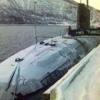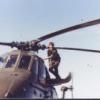Search the Community
Showing results for tags 'RotorCraft'.
-
Bell QTR (Quad Tilt Rotor) a concept from 1979. Not a 3D print but old school of creating a model from leftovers. Custom build using a Kawasaki C-1 kit (Hasegawa) and engines from V-22 Ospreys. Size comparison with a Osprey and Herc 1/200.
- 8 replies
-
- 35
-

-

-

-

-
- concept
- rotorcraft
-
(and 1 more)
Tagged with:
-
Fairey Rotodyne (A04002V) 1:72 Airfix Vintage Classics The Fairey Rotodyne was an ambitious project in the post WWII heyday of British aviation, when the aviation world could re-concentrate their efforts on more radical designs, which included the development of rotary-winged flight types that had been of interest during the 30s, but was put on the back-burner during WWII to concentrate on more pressing matters. Fairey were interested in creating a combined rotorcraft that merged autogyro with helicopter, using both type’s strengths to provide a cheaper, faster method of transport that could take-off and land vertically without the high expense associated with helicopter flight then and now. Fairey envisaged blade-tip engines powering the rotors, thereby obviating the need for a stabilising tail rotor, while the rotor would transition to autogyro mode once horizontal flight was achieved, powering down the engines and utilising the passive lift generated from the blades along with the short wings carrying a pair of turbo-prop engines that would supply forward momentum, but could also be used to counter any torque encountered during flight. The engines also supplied high-pressure air to the blade-tip engines, mixing it with fuel and burning it to provide energy to the blades to rotate. Fairey already had experience with this type of flight with their Gyrodyne, which had been demonstrated to be effective, although its size and fuel capacity limited its range substantially. It acted as a development precursor that gave Fairey confidence in its design, although the form factor and layout changed from several times during development before they settled for the twin-engined design. Which brand and type of engine became a problem however, as Fairey had their preferences, and many leading engine manufacturers considered themselves already over-stretched with various projects. Politics reared its ugly and divisive head, as the British Government had been bankrolling the project on the basis that it could be useful for military applications, and in the hope that airline BEA would make an order for at least 20 airframes to act as financial backstop for the project, which they blew hot and cold on as time went by. During the greater periods of interest, there were plans to build an enlarged variant of the Rotodyne that could carry up to 70 passengers, which would have resulted in an even more cost-effective return than the already reduced cost of the original design. The choice and power output of the engines was an ongoing issue that helped to kill the project, along with concerns over the noise caused by the rapidly spinning blade-tip engines, which were said to be painful and potentially damaging to hearing close-up, and still a nuisance even at greater distances, making conversations within range a difficult prospect. There were attempts to reduce this to a more acceptable level, and progress was beginning to be made as funding was withdrawn in the early 60s, leading to the project’s cancellation when Fairey’s new owners, Westland were likely to have to foot the bill for the completion of development. There was a good chance that the noise could have been brought down to similar or lower levels than other vehicles that were in use at the time, but it was never to happen, as the curtain was brought down on a promising project. The Kit This is a reboxing of Airfix’s vintage tooling, which was first released in 1959 while the Rotodyne was still in development, so as you’d imagine it’s a product of its time, and expectations should be measured accordingly. It is however eminently possible to create a realistic and well-detailed model from the kit, as our membership have proved in the past if you’d care to search the forum’s sub-sections. The kit arrives in a modestly sized top-opening box, and inside are eight borderless sprues in a dark grey styrene, a clear sprue, a sheet of decals, and the instruction booklet that is printed in colour on matt paper, with profiles for painting and decaling on the rear inner cover. As already mentioned, this is an old kit and should be viewed through rose-tinted glasses, as it’s even older than most of us on the forum. Considering its age, time has been kind to the moulds, with surprisingly little flash, and virtually no mould damage other than some scratches evident on the upper rotor-head and one of the tail parts at first glance. It was tooled during Airfix’s heavy riveting period, covering the skin of the kit in thousands of fine raised rivets that can be obliterated during seam filling. Construction begins with the cockpit, which is a simple floor with a moulded-in centre console with decal, and two turrets that the seats plug into, with a crew member for each seat, although they have their hands by their sides so won’t be doing much controlling of their charge unless you plan on undertaking some surgery. The cockpit is enhanced with a pair of thick control columns, and in front of the crew is an instrument panel for which a new decal has been provided, with realistic-looking dials on a grey background that look rather nice. The bulkhead behind the crew has a door moulded-in, and the nose gear leg with twin wheels is fixed to the bottom of this, putting the assembly aside while you prepare the two fuselage halves with ten oval portholes on each side, even though there is no interior present in the passenger cabin. This was the norm back in the day though, so you can either paint the interior a black shade, or build yourself a simple floor and add some seats. To close the fuselage, you will need to create the rotor-head, which consists of top and bottom halves, with a dome added to the top, and a shaft/pin inserted into the hole underneath. This and the cockpit are trapped between the two fuselage halves, taking care not to allow the glue to seep into the socket for the rotor if you wish it to remain mobile later. Seam-filling will doubtless remove some of the raised rivets on the surface, so you may wish to toy with the idea of either removing them all, converting the model to recessed rivets, or picking up some suitably pitched printed 3D rivet decals to replace those lost in the seam-filling process. The same will be true for the other external surfaces, so take it as read that this will occur for those parts of the model. The Rotodyne’s wings are simple top and bottom halves, painting a small portion of the underside interior silver because it will show through a hole in the upper wing. These are put to one side while the tail is made, creating the horizontal section from two parts plus a single flying surface that can be left mobile by not gluing them in, then adding the upper portion of the fin in two halves, and the lower portion that has a separate rudder panel, building one for each side of the model, and plugging them into the sides of the fuselage along with the wings and the surprisingly clear canopy part at the front. The two engine nacelles are split vertically in half, and are equipped with a nose with intake, through which the prop’s axle slots, securing the four-bladed propeller in position. Intakes and exhausts are added to the sides, and the main gear legs are trapped between the two nacelle halves during closure, fixing a pair of wheels to the ends of the axles. Once complete, they are pinned to the underside of the wings, and the main gear bays are given three doors each, plus another three for the nose gear leg that is now projecting from the bay under the nose. One useful feature of the Rotodyne was the clamshell rear doors that made loading cargo an easy task. These are supplied as two curved sections with four-part hinges that let them open and close if you are careful with the glue. They are locked into position by a pair of C-shaped clamps that glue to the interior of the fuselage in the tail. The penultimate task is to build the rotors themselves, adding half of the tip motors to the ends, and plugging each blade root into the rotor-head, ensuring they are installed at the same angle of attack for accuracy’s sake. The forward access door in the port side of the nose is depicted in the open position, hinging up and down in two halves, with a stairway glued to the lower portion for easy access. Markings There was only one flying Rotodyne, and it wore a fetching white, blue and silver scheme, with Fairey Rotodyne written in large text over the lower silver areas on the sides. From the box you can build the following: Decals are by Cartograf, which is a guarantee of good registration, sharpness and colour density, with a thin gloss carrier film cut close to the printed areas. Conclusion There is only one kit in this scale, and this is it. It’s an old kit, but it gets the basic shape, and despite some of the details being a little toy-like, a creditable replica can be made with a little effort. The inclusion of new decals will certainly help with that, as they are very crisply designed and printed, especially the instrument panels. Highly recommended for a vintage kit. Review sample courtesy of
-
ROTORCraft/Freightdog Models is to release 1/72nd Westland Wasp HAS.1 & Scout helicopters resin kits. Picture source: Freightdog Models (thank you !) Source: https://www.facebook.com/gary.hatcher.90260/posts/pfbid02tMCBzBdEnUe99sP4BixsFjB5MjWip47XMuk7jMQDGn85wwYiiC34RBug78AdTXeGl Source: https://www.britmodeller.com/forums/index.php?/topic/235132424-new-re-issued-freightdog-and-combat-kits-items-at-scale-modelworld-2023/ Source: https://www.britmodeller.com/forums/index.php?/topic/235132504-any-new-release-announcements-at-telford/&do=findComment&comment=4816475 Source: https://www.britmodeller.com/forums/index.php?/topic/235132504-any-new-release-announcements-at-telford/&do=findComment&comment=4816775 V.P.
- 12 replies
-
- 5
-

-
- Wasp
- Freightdog Models
-
(and 1 more)
Tagged with:
-
My second lockdown completion and another Wessex, this time a HAS3, it is the 1/72 Italeri kit with the Rotorcraft correction and External fuel tank and pylon from Air Graphics, markings came from the kit and various Modeldecal sheets some of the markings are a best guess as HMS Londons Wessex 3 seems to have been a bit camera shy and I could only find two very poor pictures of her including one that showed the name 'Cockney Rebel' but I'm happy with it _IMG9032_1 by Phillip Wilmshurst, on Flickr _IMG9029_1 by Phillip Wilmshurst, on Flickr _IMG9037_1 by Phillip Wilmshurst, on Flickr _IMG9036_1 by Phillip Wilmshurst, on Flickr _IMG9042_1 by Phillip Wilmshurst, on Flickr Anyway Enjoy Willy
- 10 replies
-
- 41
-

-

-
- Italeri
- Air Graphics
-
(and 1 more)
Tagged with:
-
Although not of the standard of some of the Wessex Helicopters shown on these pages I have finally finished my latest work a 1/72 Italeri Wessex finished as an HU5 of Lee on the Solent SAR Flight, I wanted a Lee airframe as its my local Airfield. I have used the Eduard Etched sets and the Rotorcraft correction set, paint used was from the Hataka Public services paint set. As I said its not to the the standard of some of the Wessex Helos on here, but I'm quite pleased with it. IMGP3934 by Phillip Wilmshurst, on Flickr IMGP3932 by Phillip Wilmshurst, on Flickr IMGP3931 by Phillip Wilmshurst, on Flickr IMGP3938 by Phillip Wilmshurst, on Flickr Enjoy
- 17 replies
-
- 33
-

-

-
My latest completion a long time in the making spent about 12 months on the shelf of doom just didn't have the mojo to finish it. Italeri H-19 with the Rotorcraft Whirlwind HAR9 conversion and a few scratch aerials specific to the HAR9 operated on the Endurance. IMGP2706 by Phillip Wilmshurst, on Flickr IMGP2698 by Phillip Wilmshurst, on Flickr IMGP2700 by Phillip Wilmshurst, on Flickr Alongside its HMS Protector HAR1 stablemate IMGP2710 by Phillip Wilmshurst, on Flickr Thanks for looking
- 17 replies
-
- 60
-

-

-
- Rotorcraft
- 1/72
-
(and 1 more)
Tagged with:
-
I decied to build the whirlwind after all. I dont do highly detailed models so losing the etch is no big deal I might even find it again it must be in a box somewhere. Donar kit and the converson kit sprues Marked out ready for cutting The nose is going to need some filler to make it akk join up nicely I will keep the door shut Next up get rid of the cooling grills I will use the red and blue/grey colour sheme supplied in the kit It will look nice along the HAR10 I have already. I have the kits and bits to do the MK7 and HCC12 which is what I will be doing after this one. Cockpit and grill next Rodders
- 26 replies
-
- 2
-

-
- royal navy
- has9
-
(and 2 more)
Tagged with:
-
Hi all, Just a few pictures of my 1/48 Royal Navy Westland Lynx Mk3. Thanks to Colin of Rotorcraft for a great conversion. This build is of a RN Lynx Mk 3 of 702 Squadron, RNAS Portland 1983.
-
What to build is a question I quite often ask and this time I cant find the answer? I have narrowed the list down to the kits below and would like insperation to do 1 kit for the group build to start with and maybe another if I get on well with the first build Trying not to copy anyone else (Oops I see a scout is being done :-( ) Let me know what you would build out of the following and why and I may use your idea to get my creative juices flowing Thanks Rodders
-
Hello, I'm in the midst of a Mil Mi-17 right now, and was wondering whether anybody had a good way of manipulating plastic rotor blades to give a realistic droop. This is the first whirlybird I've done in over 20 years and the first of this level of complexity, so any advice would be more than welcome.
- 11 replies
-
- techniques
- rotorcraft
-
(and 1 more)
Tagged with:







